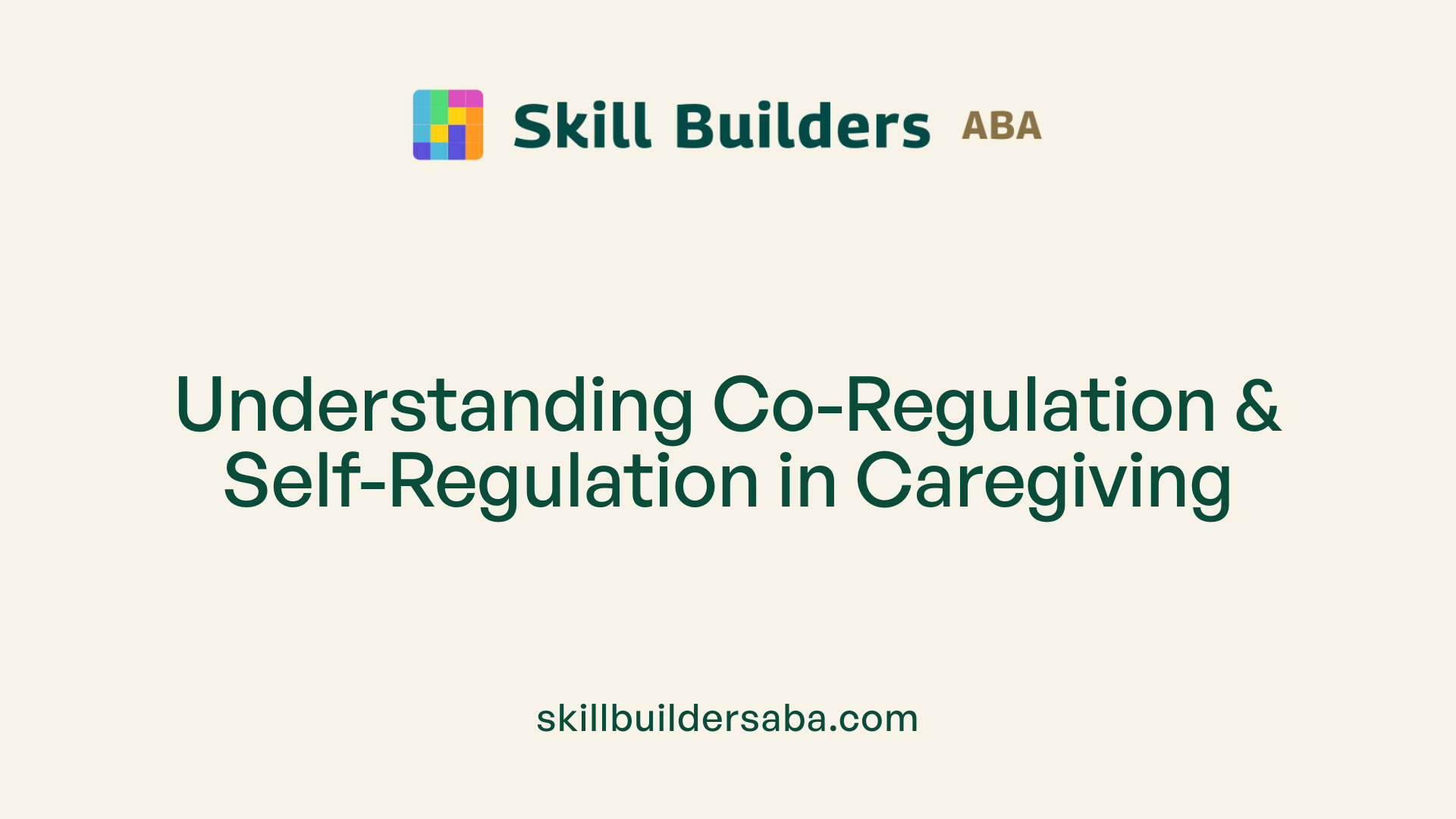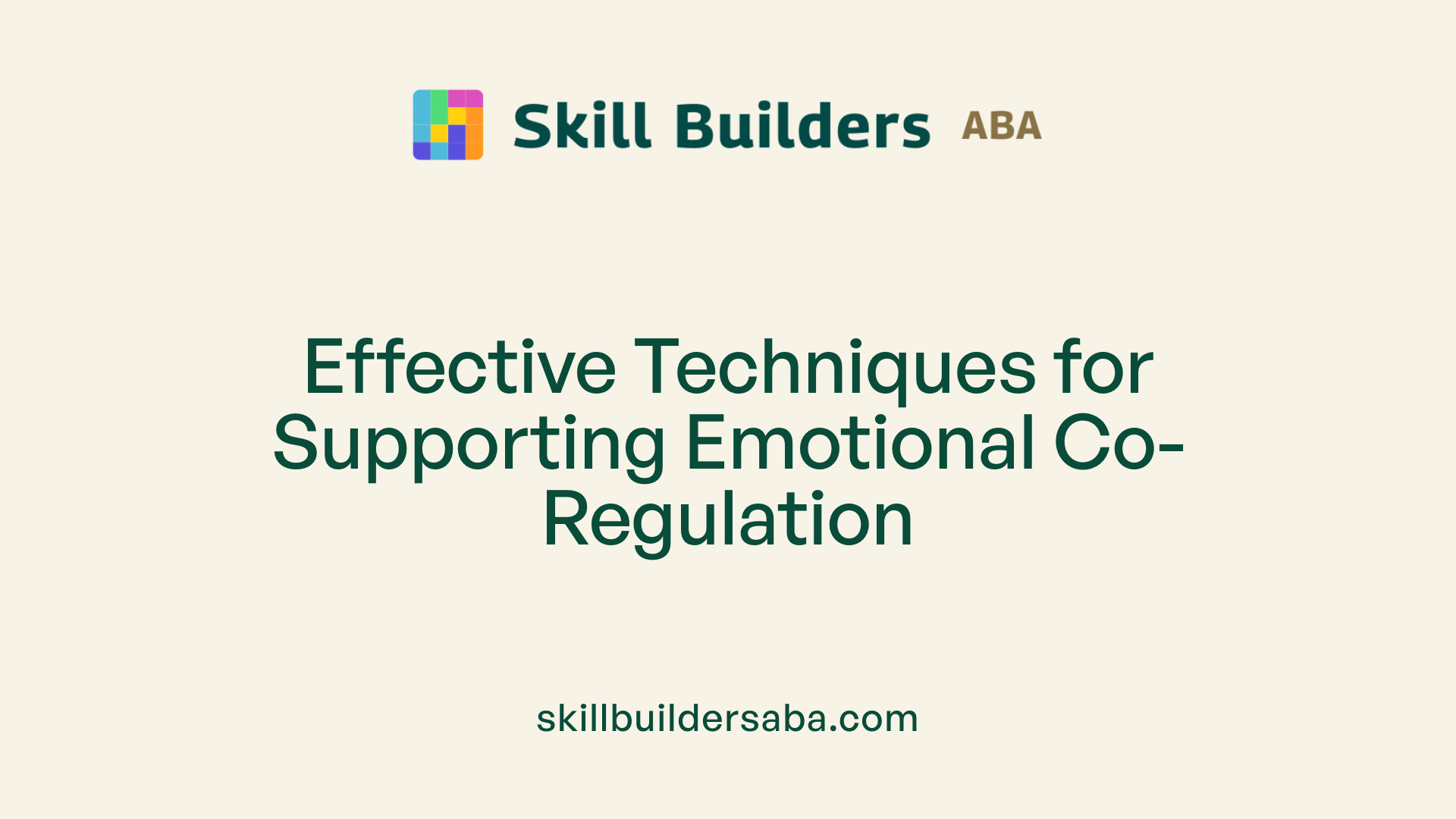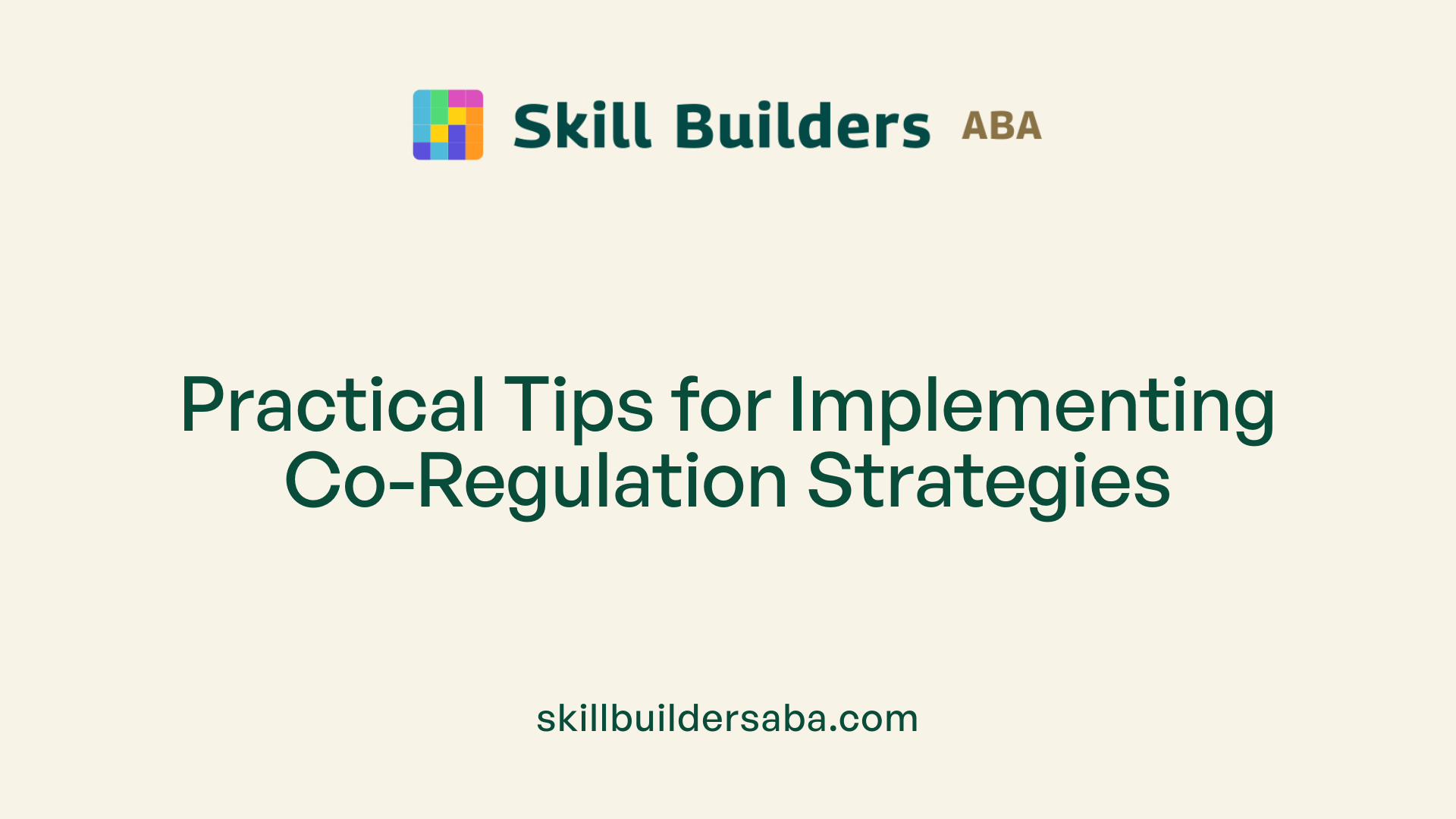
ABA tips for co-regulation with caregivers
Building Trust Through Responsive Care: Practical ABA Approaches to Co-Regulation
Understanding and Applying Co-Regulation Strategies in Caregiving and Therapy
Co-regulation is a foundational concept in emotional and behavioral development, especially vital for children with autism and other challenges. This article explores ABA-compatible tips for caregivers to foster effective co-regulation, helping children develop self-regulation skills, resilience, and trusting relationships. We will delve into what co-regulation and self-regulation are, techniques to facilitate co-regulation, supportive methods tailored for children with autism, and available educational resources to enhance caregiving practices.
Concepts of Co-Regulation and Self-Regulation in Caregiving

What are the concepts of co-regulation and self-regulation for caregivers and children?
directly involved in emotional development, co-regulation is a process where caregivers and children work together to manage feelings through connected, supportive interactions. This process helps children feel safe and understood, promoting trust and emotional resilience. When children experience distress, a trusted adult responds calmly and consistently, using strategies like recognizing emotions, gentle physical comfort, and soothing language.
This supportive process not only helps children in the moment but also teaches them how to regulate their emotions over time. Caregivers play a critical role by modeling calmness and empathy, maintaining their own emotional stability to serve as a steady 'thermostat' rather than a 'thermometer' that fluctuates with the child's emotions.
On the other hand, self-regulation refers to a child's growing capacity to independently manage their emotions, thoughts, and behaviors. It involves recognizing feelings, using coping strategies, and seeking support when needed. Developing these skills is a gradual process that benefits from consistent adult guidance, a predictable environment, and opportunities to learn through practice.
Both co-regulation and self-regulation are vital for children's overall development. While co-regulation provides the initial scaffolding, helping children learn how to calm themselves and cope with stress, self-regulation signifies a more autonomous ability to handle emotions independently. The transition from co-regulation to self-regulation involves teaching emotional awareness, modeling regulation strategies, and providing tools like visual supports or relaxation techniques.
Creating a foundation of trust, safety, and understanding through continuous, responsive interactions enables children to gradually develop the internal capacity for self-regulation. This progression is especially important for children facing additional challenges, such as those with autism, who may require targeted support and extra time to learn these skills. Overall, supportive caregiving and consistent practice foster an environment where children learn to control their emotions and behaviors, ultimately thriving emotionally and socially.
Strategies and Techniques for Facilitating Co-Regulation

What techniques and strategies can caregivers use to facilitate co-regulation?
Facilitating co-regulation involves creating an environment of safety, trust, and responsiveness. Caregivers play a vital role in modeling calmness and emotional control, which helps children learn how to manage their own emotions later on. Maintaining a warm, responsive relationship forms the foundation of effective co-regulation.
One of the primary strategies is for adults to manage their own emotional state. Staying calm, even during challenging moments, allows caregivers to act as a steady anchor for the child. Techniques such as using a soft, soothing voice, making gentle eye contact, and labeling the child's feelings (e.g., "You seem frustrated") validate their emotions and show understanding.
Providing physical comfort, such as a comforting touch or holding, can help soothe children, especially when they are overwhelmed. Guided calming exercises like deep breathing or sensory strategies tailored to the child's needs are also effective tools that caregivers can use.
Creating an environment that offers predictability and safety is crucial. Regular routines, visual supports, and a calm atmosphere help children feel secure and supported in their emotional development.
Strategies should be adapted to the child's developmental stage. For infants, physical closeness and gentle reassurance are vital. For preschoolers, emotion labeling and simple coping strategies work well. As children grow into adolescence, fostering autonomy while providing support becomes important.
Active listening and being present are fundamental. Caregivers should observe the child’s responses carefully, validate their feelings, and reinforce coping skills. Using visual supports, like emotion charts or calming tools, can further enhance understanding and regulation.
Together, these techniques foster a safe space where children learn that their feelings are understood and that support is available, encouraging the development of self-regulation over time.
How does adult self-regulation influence co-regulation?
Adult self-regulation is essential because children often mirror the emotional state of their caregivers. When adults stay calm and composed, they serve as positive models for emotional regulation. An adult acting as a calm 'thermostat' rather than a reactive 'thermometer' creates a stable environment that promotes safety.
Practicing self-awareness allows caregivers to recognize their own stress signals and modulate their responses accordingly. This consistency helps children feel secure and understood, which is fundamental for effective co-regulation.
By managing their own emotions, caregivers can respond more effectively to children's needs, promote trust, and foster emotional literacy. This reciprocal process emphasizes that co-regulation is not solely about the child's behavior but also how adults manage their internal states.
Why is creating a predictable environment important?
Predictability offers children a sense of control and safety, reducing anxiety and emotional distress. Visual routines, consistent responses, and familiar surroundings help children with developing secure attachments.
This stability supports their ability to regulate emotions and behaviors, especially in moments of stress or overwhelm. For children facing trauma or sensory sensitivities, such consistency is even more critical.
How do strategies vary across developmental stages?
Infants benefit from close physical contact, soothing voices, and gentle touches to feel secure.
Preschoolers thrive with emotion labels, simple coping activities, and reassurance.
Older children and adolescents are best supported through fostering autonomy, encouraging self-awareness, and involving them in problem-solving within a safe framework.
Tailoring approaches ensures that each child’s unique needs and development are addressed, enhancing the effectiveness of co-regulation.
What are effective ways to practice active listening and reinforcement?
Active listening involves paying full attention to the child, acknowledging their feelings, and responding empathetically. Using verbal affirmations like “I see you’re upset” or “That sounds hard” demonstrate understanding.
Reinforcing coping strategies, such as deep breathing or using sensory tools, encourages children to apply these skills independently over time.
Incorporating visuals like emotion charts or calming images further supports expression and regulation.
Through consistent practice, children learn that they are supported and that regulation is achievable, promoting resilience and emotional growth.
Implementing Co-Regulation Strategies in Practice

How can caregivers implement co-regulation strategies to support emotional regulation in children?
Caregivers play a vital role in helping children learn to manage their emotions through co-regulation. This process involves creating a warm, secure environment characterized by consistency and predictability. Maintaining calm demeanor and responding promptly to emotional cues help establish a sense of safety and trust.
Modeling emotion recognition and regulation in real-time is essential. When caregivers verbalize their own feelings and demonstrate calming strategies, children learn how to identify and manage their emotions. For example, using a gentle voice, offering reassurance, or guiding a child through deep breathing can model effective coping.
Visual supports, such as emotion charts or pictures, are particularly useful for children with autism or communication challenges. These tools help children recognize and express feelings, making regulation more accessible.
Incorporating sensory-friendly modifications and ensuring an environment with stability and minimal overstimulation support a child's ability to regulate. This can include soft lighting, calming textures, or designated quiet spaces.
Active engagement in proactive and responsive interactions allows caregivers to tailor their approach based on individual needs. This includes using familiar routines, providing physical comfort when appropriate, and validating feelings to reinforce emotional understanding.
Building strong, responsive relationships anchored in safety and understanding encourages children to develop self-regulation skills over time. Caregivers should remain attuned to the child's cues, adjusting their strategies as needed and fostering a sense of mutual trust.
For children with autism, these strategies are especially critical. Since many experience sensory sensitivities and communication difficulties, structured and predictable interactions provide a foundation for emotional growth.
Progression from co-regulation to self-regulation involves teaching children to recognize their feelings, use coping tools, and seek support when needed. Consistent practice, patience, and positive reinforcement are integral to this developmental process.
Lastly, caregivers should prioritize their own emotional regulation, modeling calmness and presence. This not only stabilizes the interaction but also sets a standard for children to emulate, reinforcing the importance of managing emotions within relational contexts.
Practical Strategies Summary
| Strategy | Description | Additional Detail |
|---|---|---|
| Warm, secure environment | Establishing a safe space with routines | Predictable routines reduce anxiety and promote regulation |
| Modeling emotional regulation | Demonstrating recognition and calming techniques | Using simple language and visible cues |
| Visual supports | Using charts or pictures for feelings | Especially helpful for non-verbal children or those with sensory challenges |
| Sensory modifications | Tailoring environment to sensory needs | Soft lighting, textures, quiet areas |
| Responsive interactions | Adjusting responses based on child's cues | Tailoring supports and providing reassurance |
Building effective co-regulation practices involves continuous learning and adaptation. The goal is to nurture a child's capacity for emotional resilience, setting the stage for stronger self-regulation over time.
Specialized Co-Regulation Approaches for Children with Autism

What are effective co-regulation methods specifically designed for children with autism?
Children with autism often face unique challenges in emotional regulation due to sensory sensitivities and communication difficulties. Tailored co-regulation strategies are essential to support their emotional development and help them manage distress.
One of the most effective tools is the use of visual supports. Visual aids such as emotion charts, 'I feel' and 'I need' visuals, and other pictorial resources help children identify and understand their feelings. These supports can serve as cues that make abstract emotions more concrete, encouraging children to express themselves more easily.
Creating a predictable and safe environment is also crucial. Routine consistency and sensory-friendly modifications foster trust and reduce anxiety. For example, predictable schedules and designated calming areas help children anticipate what comes next and find comfort when overwhelmed.
During moments of dysregulation, adults should respond with warmth, clarity, and calmness. Using a gentle voice and simplified language can prevent escalation. Caregivers are encouraged to follow the child's lead, validating their feelings while providing reassurance through touch, verbal affirmations, and breathing exercises.
Physical comfort forms an important part of co-regulation. Simple strategies like holding the child's hand or offering a comforting object can have a calming effect. Verbal reassurance coupled with visual cues helps children reconnect with a sense of safety.
Proactively constructing safe, calming spaces within the child's environment is another core approach. These spaces can be customized with sensory tools, soft lighting, or comforting textures, allowing children to regain regulation without feeling overwhelmed.
Finally, a collaborative approach—co-constructing safe spaces and using proactive, responsive interactions—builds trust and promotes emotional resilience. When adults consistently model regulation and respond to the child's cues with empathy and patience, they create a secure environment conducive to emotional growth.
| Strategy | Description | Additional Details |
|---|---|---|
| Visual support tools | Using emotion charts and visual cues to aid expression | Supports emotional literacy and understanding |
| Routine and sensory modifications | Establishing predictable routines and sensory-friendly spaces | Enhances stability and trust |
| Calm, clear communication | Responding with warmth, calmness, and simple language | Prevents escalation, models self-regulation |
| Physical and verbal reassurance | Using touch and gentle words during distress episodes | Provides comfort and reassurance |
| Safe calming environments | Creating spaces with sensory tools and soothing elements | Helps children self-regulate and feel secure |
Developing emotional regulation in children with autism is a process requiring patience, consistency, and tailored approaches. These strategies, rooted in understanding and compassion, can significantly improve their ability to navigate overwhelming emotions, fostering resilience and independence.
Empowering Caregivers to Foster Emotional Resilience
Effective co-regulation is a cornerstone of ABA therapy and caregiving, especially for children facing emotional and sensory challenges. By understanding the dynamics of co- and self-regulation, utilizing tailored techniques, and leveraging available resources, caregivers can build trusting, responsive relationships that facilitate emotional growth. Continued practice and patience are vital, as developing regulation skills is a long-term journey. With commitment, education, and empathy, caregivers can create supportive environments where children feel safe, understood, and empowered to manage their emotions confidently.
References
- Co-regulation Strategies: Tips for Providers, Parents and ...
- What is Co-Regulation? A Parent's Guide to Supporting ...
- Pro Tips: Co-regulation and self-regulation
- The Power of Co-Regulation and Interoception
- Co-regulation: Helping children and teens navigate big ...
- Co-Regulation vs. Self-Regulation: Why Both Are Crucial ...
- What Is Co-Regulation?
- The Role of Co-Regulation in Building Self-Regulation Skills
- Co-Regulation vs. Self-Regulation: Why Both Are Crucial ...
- Co-Regulation: Tools to Support Kids' Emotions
Reach Out Today
Learn more about how we can support your child’s growth and development. Contact us to discuss our services and availability in your area.
.svg)